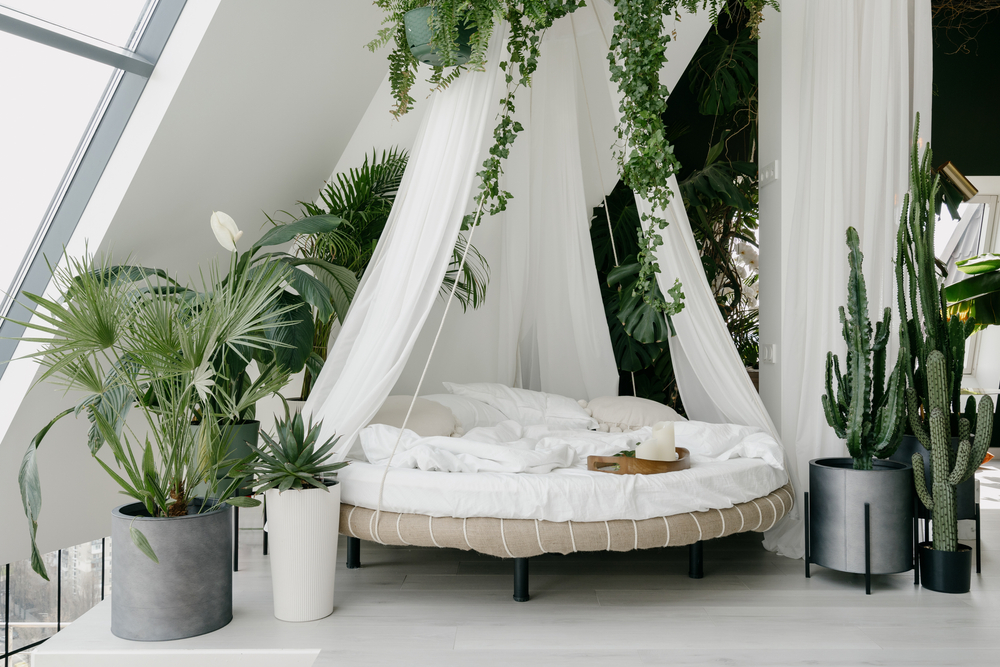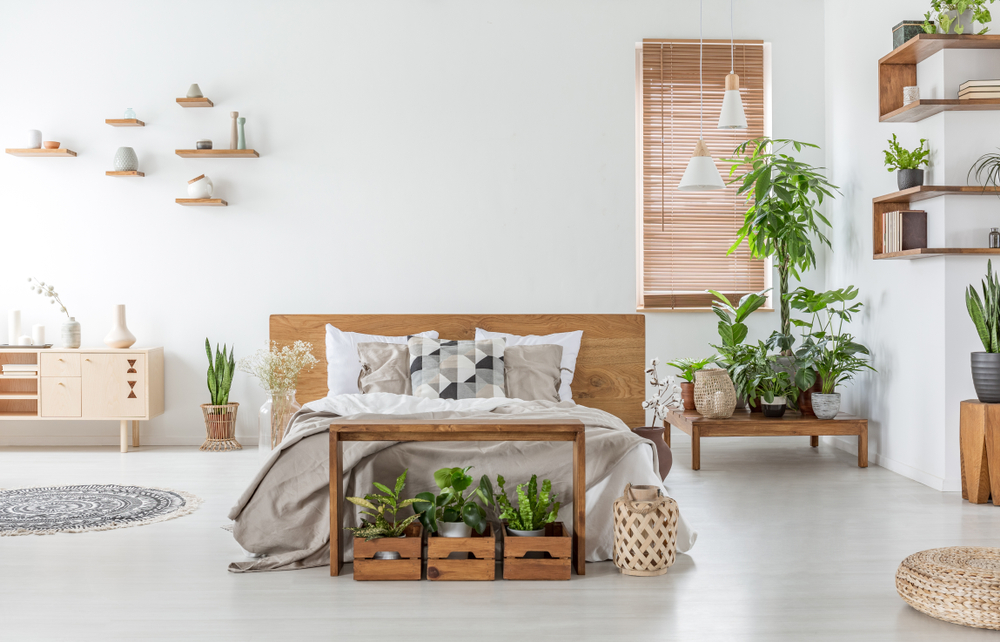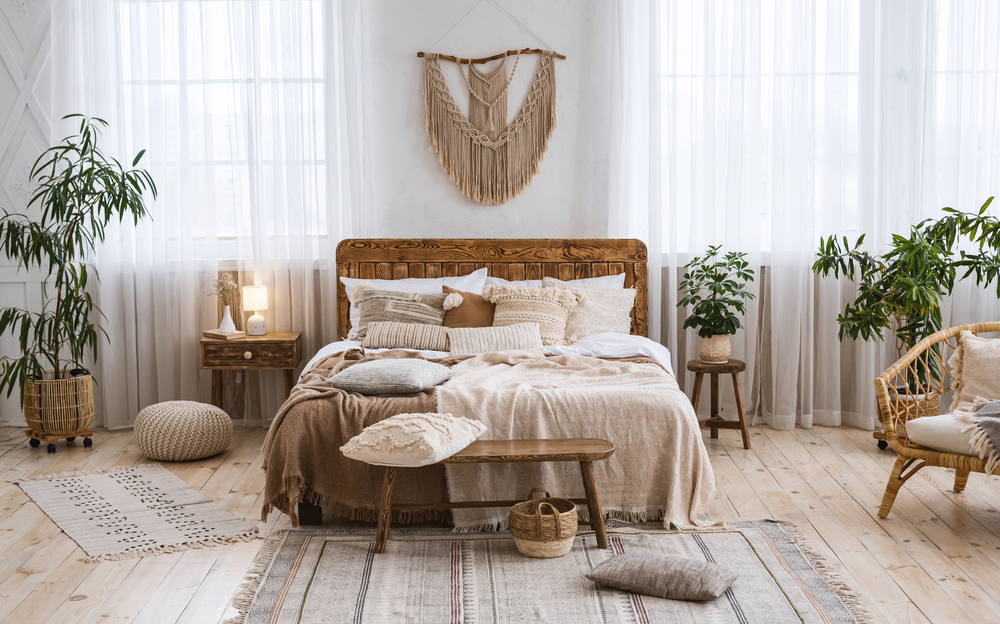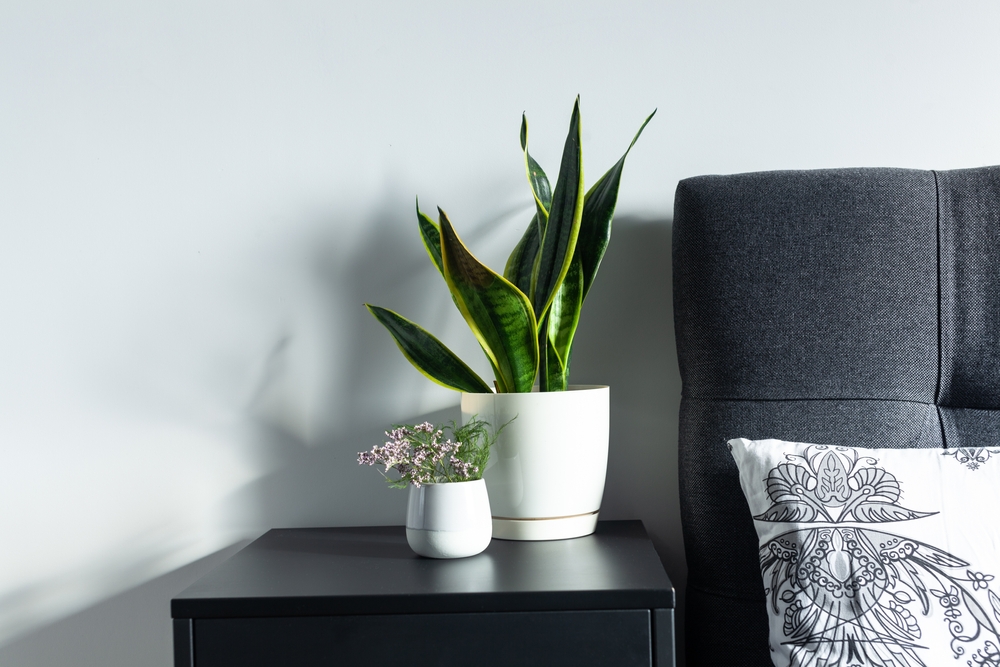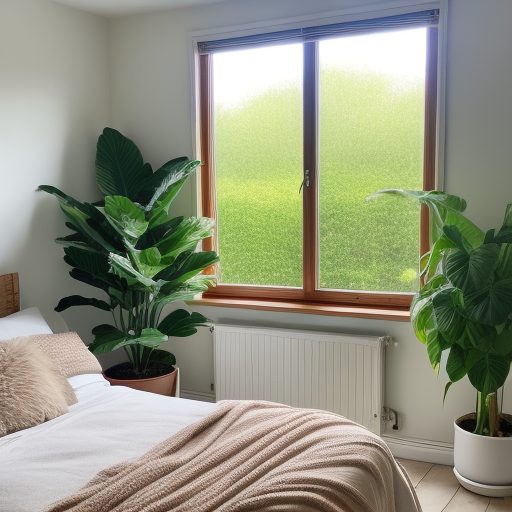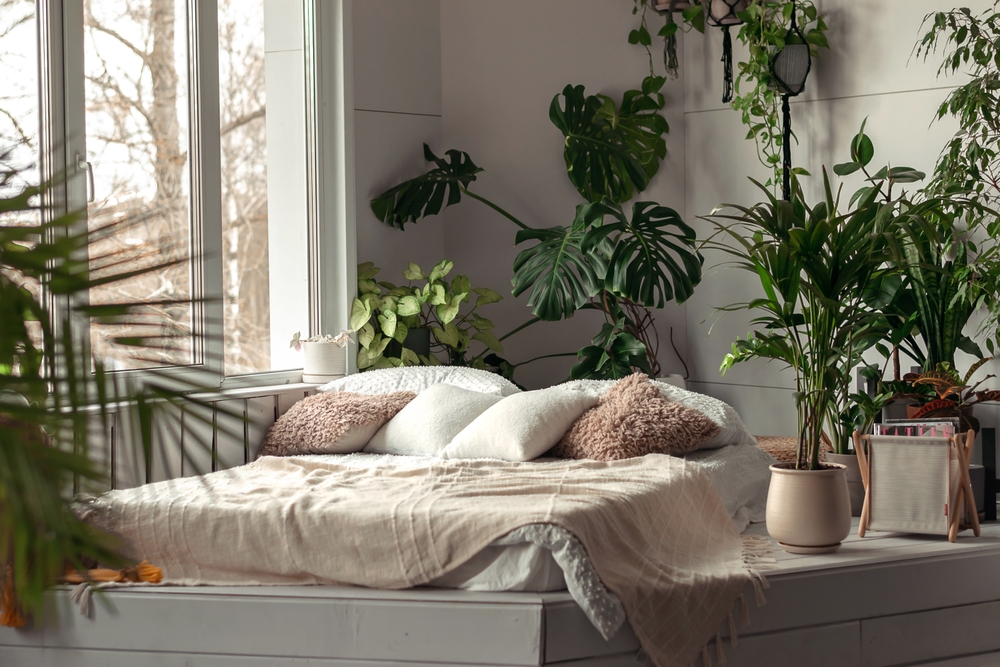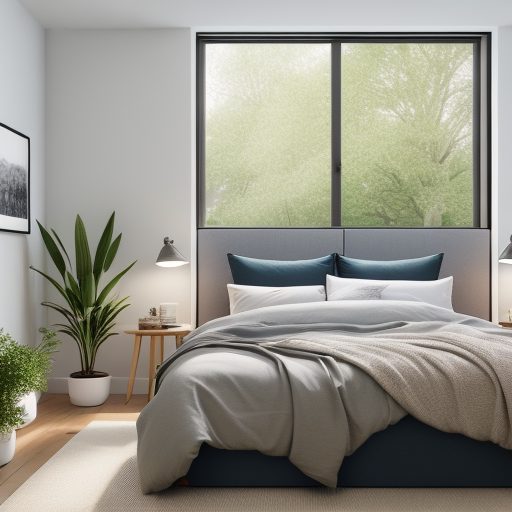HousePlantJoy is supported by our audience. When you purchase through one of our links, we may earn a small affiliate commission. As an Amazon Associate I earn from qualifying purchases. Your cost is not affected.
==================
Hey there, tired of tossing and turning in a stuffy bedroom? You’re not alone! Poor air quality can be a real sleep and health saboteur. But guess what? We’ve got a breath of fresh air for you – literally! Say hello to your new green roommates, indoor plants. Not only do they bring a touch of nature’s beauty into your space, but they also work tirelessly behind the scenes to purify the air, making your bedroom a healthier and cozier place to be. So, let’s dive into the world of bedroom plants and discover how these leafy companions can transform your sleep and well-being.
Best Plants for Bedroom Air Quality: Top Picks to Improve Your Sleep
Have you ever noticed that sometimes your bedroom air feels a bit, well, stuffy? It’s not just you! Indoor air pollution is a sneaky issue that often lurks in bedrooms, causing a bunch of problems like allergies, stuffy noses, and even those dreaded headaches. But here’s a simple solution that not only adds a touch of green beauty to your space but also works like a natural air superhero – plants!
Now, let’s talk about what’s cooking in the air quality department. Your bedroom’s air quality can take a hit from everyday culprits like pet fur, dust, and those chemical residues from cleaning products. And trust us, poor air quality isn’t your BFF; it can make your eyes itch, your nose sneeze, and even give you that ‘I-need-an-expresso’ kind of fatigue. Since your bedroom is where you catch those ZZZs and recharge, it’s high time to make it an air quality oasis.
So, why should you consider bringing some leafy pals into your sleeping quarters? Well, it turns out plants are like the ultimate detoxifiers for your indoor air. They have a knack for gobbling up nasty stuff like formaldehyde, benzene, and trichloroethylene, and then magically converting it into the good stuff – oxygen! Plus, some of these green buddies are also masters at bumping up the humidity, which is excellent news for dry skin and those occasional respiratory hiccups. And here’s the cherry on top – they’re stress-busters, too! So, by adding a few plants to your bedroom, you’re not just cleaning the air; you’re creating a calming and relaxing sanctuary.
Key Takeaways
- Adding plants to your bedroom can significantly improve air quality and reduce the risk of health issues.
- Plants are natural air purifiers that absorb harmful toxins and convert them into oxygen.
- In addition to improving air quality, plants can also reduce stress levels and promote a sense of calm and relaxation.
Understanding Bedroom Air Quality
You know what’s a game-changer for your nights and your well-being? Yep, it’s the air quality in your bedroom. Picture this: good air quality equals better sleep and a healthier you. But here’s the catch – if your room’s air is less than stellar, it can tag along with a crew of respiratory issues, allergies, head-throbbing headaches, and a special guest appearance by the ‘I-need-a-nap’ fatigue.
But hey, don’t hit the panic button just yet. In this section, we’re about to dive into the nitty-gritty stuff. We’ll chat about what’s behind the scenes, the backstage players messing with your air quality, and – the best part – how to kick them out and invite fresh, clean air in. So, let’s roll up our sleeves and get to the bottom of this bedroom air quality mystery!
Humidity
Humidity refers to the amount of water vapor in the air. High humidity can lead to mold growth, while low humidity can cause dry skin and respiratory problems. The ideal humidity level for the bedroom is between 30% and 50%.
Toxins
Toxins are harmful substances that can be found in the air. Formaldehyde, benzene, xylene, and trichloroethylene are some of the most common toxins found in indoor air. They are released from furniture, carpets, and cleaning products. Exposure to these toxins can cause headaches, dizziness, and respiratory problems.
Carbon Dioxide
Carbon dioxide is a gas that is naturally present in the air. However, high levels of carbon dioxide can cause headaches, dizziness, and fatigue. Carbon dioxide levels can increase in the bedroom due to poor ventilation and the presence of plants.
Allergens
Allergens are substances that can cause an allergic reaction. Dust mites, pet dander, and pollen are some of the most common allergens found in the bedroom. Exposure to these allergens can cause respiratory problems, itching, and sneezing.
Improving bedroom air quality can be achieved by maintaining a clean and well-ventilated space. Using an air purifier, opening windows, and using natural cleaning products can also help. Additionally, incorporating plants that purify the air can be an effective way to improve bedroom air quality.
Importance of Plants in Improving Air Quality
When it comes to our health, we often think about diet and exercise, but there’s another player in the game we might overlook – the air we breathe indoors. That’s where our leafy friends, houseplants, come into play. These indoor wonders not only look great but also pull off some serious air-cleaning magic.
You won’t believe what NASA found out! They did a study and discovered that certain air-purifying plants are like the superheroes of the plant world. They can swoop in and rescue your indoor air by eliminating up to a whopping 87% of volatile organic compounds (VOCs) within just 24 hours. Impressive, right?
Now, let’s talk about the breath of fresh air – quite literally – that plants bring. Plants are like little oxygen factories, thanks to a process called photosynthesis. They chow down on carbon dioxide and generously serve up oxygen, making your room’s air quality top-notch. And this is perfect for your bedroom, where you do all that cozy sleeping and deep-breathing.
But here’s the real kicker: these green buddies are more than just air refiners; they’re masters of detox too. They have a knack for munching on airborne nasties like formaldehyde, benzene, and trichloroethylene. Some of the MVPs in this category include the peace lily, spider plant, snake plant, and trusty aloe vera.
And it doesn’t stop there! If you’re plagued by dry skin or breathing issues, plants can come to the rescue. They’re like natural humidifiers, sipping water from their pots and releasing it into the air through a fancy process called transpiration. So, they don’t just clean your air; they make it comfier too.
Summing it up, inviting indoor plants into your bedroom is like welcoming a team of air-quality heroes. They don’t just deliver oxygen and boot out toxins; they also crank up the humidity and bring a touch of nature’s elegance to your space.
Best Plants for Bedroom Air Quality
Having plants in the bedroom can improve air quality and help you sleep better. Some of the best plants for bedroom air quality include:
- Peace Lily: This plant is great for removing toxins such as formaldehyde, benzene, and trichloroethylene from the air. It also adds moisture to the air, making it a great choice for those with dry skin or respiratory issues.
- English Ivy: English ivy is known for its ability to remove mold from the air, making it a great choice for those with allergies or asthma. It also helps to remove formaldehyde and benzene from the air.
- Snake Plant: Also known as mother-in-law’s tongue, this plant is great for removing toxins such as formaldehyde, benzene, and trichloroethylene from the air. It also releases oxygen at night, making it a great choice for the bedroom.
- Philodendron: This plant is great for removing formaldehyde from the air. It’s also easy to care for and can grow in low light conditions.
- Pothos: Pothos is great for removing formaldehyde and benzene from the air. It’s also easy to care for and can grow in low light conditions.
- Spider Plant: Spider plants are great for removing formaldehyde and benzene from the air. They’re also easy to care for and can grow in low light conditions.
- Aloe Vera: Aloe vera is great for removing formaldehyde from the air. It also releases oxygen at night, making it a great choice for the bedroom.
- Rubber Plant: Rubber plants are great for removing formaldehyde from the air. They’re also easy to care for and can grow in low light conditions.
- Areca Palm: Areca palms are great for removing formaldehyde, benzene, and trichloroethylene from the air. They’re also great for adding moisture to the air.
- Lavender: Lavender is known for its calming properties and can help you sleep better. It also helps to reduce stress and anxiety.
These plants are just a few examples of the many plants that can improve air quality in the bedroom. When choosing plants for the bedroom, it’s important to consider their care requirements and how they will fit into your space.
Plant Care and Maintenance
You know, if you want your bedroom plants to thrive – and let’s be honest, who doesn’t? – taking care of them is the name of the game. It’s not just about keeping them alive; it’s about helping them flourish, and guess what? It’s a win-win because it can also level up your bedroom’s air quality.
So, here’s the deal – we’ve got some tips up our sleeves to make plant care a breeze. Think of it as your secret recipe for turning your space into a lush green paradise:
Watering
Overwatering is a common mistake that can lead to root rot and the death of your plant. It’s important to water your plants only when the soil is dry to the touch. The frequency of watering will depend on the type of plant and the amount of sunlight it receives. Plants in low-light conditions will require less water than those in bright, direct sunlight.
Lighting
Lighting is an essential factor in the growth and health of your plants. Some plants thrive in low-light conditions, while others require bright, direct sunlight. If your bedroom has an east-facing window, it can provide your plants with the natural light they need. If your room doesn’t get enough natural light, you can use artificial light to supplement it.
Hanging Baskets
Hanging baskets are a great way to add greenery to your bedroom while saving floor space. When choosing a hanging basket, make sure it has drainage holes to prevent overwatering. You can also add pebbles to the bottom of the basket to improve drainage.
Propagation
Propagation is the process of growing new plants from cuttings or other plant parts. It’s a great way to expand your plant collection and share your plants with others. Some plants are easier to propagate than others, so it’s important to do your research before attempting it.
In summary, proper care and maintenance are essential for the health and growth of your bedroom plants. By following these tips, you can help improve the air quality in your bedroom and enjoy the benefits of having greenery in your space.
Health and Wellness Benefits of Bedroom Plants
You know what’s cooler than just having a stylish bedroom? Having one that’s not just easy on the eyes but also gives your health and well-being a high-five. And guess what’s the secret sauce for this perfect blend of aesthetics and wellness? Indoor plants!
These leafy buddies don’t just stand there looking pretty; they’ve got a whole bunch of health and wellness benefits up their sleeves. Let’s spill the beans on why you should consider turning your bedroom into a mini-jungle:
Better Sleep
Certain plants can help induce sleep and improve the quality of sleep. Jasmine, for instance, has a soothing effect that can help reduce anxiety and promote better sleep. Aloe Vera is another plant that can improve sleep quality by purifying the air and releasing oxygen at night.
Allergy Relief
Plants such as Spider Plant, Peace Lily, and Boston Fern are known for their air-purifying properties. They can help remove toxins from the air, including allergens such as dust and pollen, and improve air quality. This can be especially beneficial for people suffering from allergies.
Skin Health
Plants can also help improve skin health. Aloe Vera, for example, has anti-inflammatory properties that can help soothe skin irritation and promote healing. The Snake Plant is another plant that can help improve skin health by removing toxins from the air and improving air quality.
Flu Prevention
Plants such as Eucalyptus and Peppermint can help prevent the flu by releasing essential oils that have antiviral properties. These oils can help purify the air and kill airborne viruses and bacteria.
Anxiety Relief
Plants can also help reduce anxiety and promote relaxation. Lavender, for example, has a calming effect that can help reduce stress and anxiety. The Snake Plant is another plant that can help reduce anxiety by purifying the air and improving air quality.
In conclusion, indoor plants can provide numerous health and wellness benefits for the bedroom. From improving air quality to promoting better sleep and reducing anxiety, adding plants to the bedroom can help enhance overall well-being.
Interior Design With Plants
Plants are a great way to add a touch of greenery to any indoor space. Not only do they bring life to a room, but they can also improve air quality and create a calming atmosphere. Incorporating plants into interior design can be done in a variety of ways, from hanging baskets to trailing vines.
When it comes to choosing plants for interior design, it is important to consider the space and lighting. Some plants require more sunlight than others, and some thrive in increased humidity. For those with limited natural light, there are plenty of indoor plants that can thrive in low light conditions.
Trailing plants are a popular choice for interior design, as they can add a touch of greenery to any space without taking up too much room. Some popular trailing plants include English Ivy, String of Pearls, and Golden Pothos. These plants can be grown in hanging baskets or trained to grow up a trellis.
In addition to adding a touch of greenery to a room, plants can also improve air quality. NASA has conducted research on the air-purifying capabilities of plants, and some of the best plants for improving air quality include the Snake Plant, Spider Plant, and Peace Lily.
When it comes to incorporating plants into interior design, the possibilities are endless. From outdoor plants to trailing vines, there are plenty of options to choose from. With a little bit of research and creativity, anyone can create a beautiful and calming indoor space with the help of plants.
Where to Buy Bedroom Plants
So, you’re all excited about the idea of adding some green goodness to your bedroom, right? Well, the good news is you’ve got a bunch of options to choose from. It’s like a plant shopping spree out there! You can hop over to your local nursery, check out garden centers, browse the aisles of home improvement stores, or even go the online route.
But, hey, before you embark on your plant quest, it’s worth knowing that each option comes with its own set of perks and quirks. So, let’s break it down, shall we? Here’s the lowdown on where to snag your bedroom buddies, and what to keep in mind while you’re at it.
Local Nurseries and Garden Centers
Local nurseries and garden centers are great places to buy plants. They usually offer a wide selection of plants, including those that are suitable for the bedroom. You can also get advice from knowledgeable staff on which plants are best for your specific needs. However, the prices at nurseries and garden centers can be higher compared to other options.
Home Improvement Stores
Home improvement stores like Home Depot and Lowe’s also carry a variety of plants, including those that are suitable for the bedroom. They often have a larger selection than local nurseries and garden centers, and the prices are usually more affordable. However, the quality of the plants may not be as good as those from a nursery or garden center.
Online Retailers
Online retailers like Amazon and Costa Farms offer a convenient way to purchase plants without leaving your home. They have a wide variety of plants, and you can easily compare prices and read reviews from other customers. However, you can’t physically inspect the plants before purchasing, and shipping can be expensive.
Costa Farms
Costa Farms is a popular online retailer that specializes in plants. They offer a wide selection of plants, including those that are suitable for the bedroom. They also provide detailed care instructions for each plant, which can be helpful for beginners. Costa Farms’ prices are competitive, and they offer free shipping on orders over $50.
In conclusion, there are several options available for buying bedroom plants, each with its own advantages and disadvantages. It’s important to consider your needs and preferences before making a purchase. Whether you choose to buy from a local nursery, home improvement store, or online retailer like Costa Farms, make sure to choose a plant that is suitable for your specific needs and environment.
Video Credit: @Planterina
Green Dreams for Your Bedroom: The Conclusion
Alright, we’ve taken a delightful journey through the world of bedroom plants and their incredible superpowers. As we wrap up, let’s recap the lush benefits of having these green pals in your sleep haven.
First off, they’re more than just pretty faces; they’re the silent guardians of your air quality. With a penchant for gobbling up toxins like formaldehyde and benzene, they’re like little detoxifying wizards, making your indoor air fresher and healthier.
But that’s not all! They’re your 24/7 oxygen suppliers, thanks to their nifty photosynthesis skills. So, take a deep breath – your bedroom is now a personal oxygen bar!
And if you’ve ever battled dry skin or late-night coughs, these indoor warriors are here to save the day. By boosting humidity levels, they transform your room into a cozy oasis.
So, here’s the deal: bedroom plants are more than just room décor; they’re health boosters, stress busters, and air quality improvers, all rolled into one leafy package.
Ready to dive deeper into the green revolution for your bedroom? Be sure to check out our website for all the tips, plant recommendations, and inspiration you need to turn your space into an indoor garden of dreams. Happy planting, and sweet dreams!
Frequently Asked Questions
Which indoor plant purifies the air the most?
According to a study conducted by NASA, the peace lily (Spathiphyllum) is one of the most effective air-purifying indoor plants. It can remove common household toxins such as benzene, formaldehyde, and trichloroethylene.
What is the best plant in the bedroom for sleep?
Plants that release oxygen at night and improve air quality can help promote better sleep. Some of the best bedroom plants for sleep include lavender, jasmine, and snake plant (Sansevieria). These plants have calming and soothing effects that can help reduce stress and anxiety.
What plant removes 78% of airborne mold?
The English Ivy (Hedera helix) is known to remove up to 78% of airborne mold in just 12 hours. It is a trailing plant that can be placed on a nightstand or hung in a planter.
What are NASA's top 10 air purifying plants?
NASA’s top 10 air purifying plants include the peace lily, snake plant, bamboo palm, spider plant, golden pothos, chrysanthemum, red-edged dracaena, weeping fig, aloe vera, and the rubber plant. These plants are effective at removing common household toxins and improving air quality.
What are some low-maintenance indoor plants for clean air?
Some low-maintenance indoor plants that can help purify the air include the spider plant, snake plant, peace lily, and Chinese evergreen. These plants require minimal care and can thrive in low light conditions.
Are there any indoor plants that purify the air and are safe for pets?
Yes, there are several indoor plants that are safe for pets and can help purify the air. These include the spider plant, Boston fern, bamboo palm, and areca palm. However, it is important to note that some plants can be toxic to pets, so it is always best to research a plant’s toxicity before bringing it into a home with pets.
? Hey Plant Lovers, Let’s Grow Together! ?
Ready to immerse yourself in a world of vibrant houseplants, inspiring home design, and gardening adventures? ? Join our passionate community and explore engaging content, authentic product reviews, and valuable tips.
? Follow us on social media:
- Dive into conversations on Facebook: Houseplant Joy on Facebook
- Get your daily dose of plant beauty on Instagram: Houseplant Joy on Instagram
- Pin your dream garden on Pinterest: Houseplant Joy on Pinterest
- Stay in the know with Twitter: Houseplant Joy on Twitter
But wait, there’s more! Don’t miss our newsletter for exclusive plant-loving content delivered to your inbox. ?? Let’s nurture our green passions together! #PlantLoversUnite #GreenThumbs



